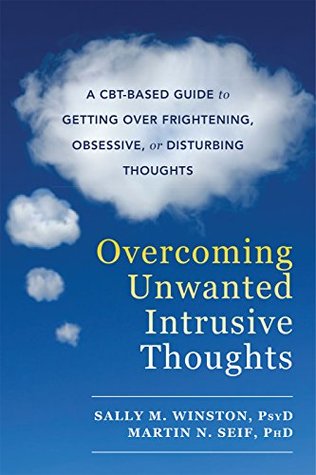More on this book
Community
Kindle Notes & Highlights
Started reading
November 26, 2024
The authors crystallize decades of experience into a perfectly clear and readable guide.
Sally Winston and Martin Seif have put all the pieces of the puzzle together to help people understand and overcome unwanted intrusive thoughts.
It speaks to those who suffer intensely from unwanted intrusive thoughts and, as a result, descend into a world of anxious isolation.
Two expert psychologists explain unwanted intrusive thoughts, and show you how to break free from the cycles that strengthen their grip on you.
With the strategies in this book, we learn how to reduce the stress and distress thoughts can trigger, and this takes away the power of those thoughts.
Do you live in dread that having bizarre, repetitive, repugnant, or unrelenting thoughts means something shameful or terrible about you?
Our first message is that you are not alone.
You bear your burdens in isolation, not knowing that there are many others just like you.
Our second message is that you are very brave.
Trying to keep thoughts out of your mind doesn’t work for you. It doesn’t work for anybody.
There is nothing wrong with you, just the way you are dealing with your thoughts.
Remember that knowledge is power, and the more you know about unwanted intrusive thoughts, the better you will be able to free yourself from the misery they bring.
Good explanations are good treatment.
Just knowing accurate information about unwanted intrusive thoughts will make them feel less distressing.
The answer is learning an entirely new relationship to thoughts, which is being neither scared nor ashamed of them.
It was just a thought not worth even considering what it means.
Chances are, you don’t want it because you are upset or turned off by the content.
It contains an urgent feeling of needing to get rid of it.
The content of many unwanted intrusive thoughts is aggressive, sexual, taboo, anxiety-provoking, or self-derogatory.
An unwanted intrusive thought sometimes feels like an impulse to perfo...
This highlight has been truncated due to consecutive passage length restrictions.
Unwanted intrusive thoughts tend to recur repeatedly and seem to increase in intensity over time.
Our mind has many natural voices, and their interplay makes our mental lives interesting and colorful.
In the case of unwanted intrusive thoughts, there are three voices that are particularly relevant.
Worried Voice articulates the fears and doubts and misguided conclusions that predict tragedies and awful outcomes.
The simple truth is that what you resist tends to persist.
Thoughts stick because of the energy you expend to fight them.
Thoughts about chairs and fruit salad and trees don’t stick because they are neutral thoughts.
Unwanted intrusive thoughts get stuck because you inadvertently fuel them by trying to push them away.
Your brain is issuing warnings where none are needed.
Suffering about unwanted intrusive thoughts is a disorder of overcontrol, not undercontrol.
Disorders of overcontrol are usually accompanied by a problem with ...
This highlight has been truncated due to consecutive passage length restrictions.
People who are impulsive act first and think later. People with unwanted intrusive thoughts are over-thinkers.
Unwanted intrusive thoughts fluctuate in frequency and intensity.
The day after consuming alcohol is usually a sticky day for most people.
As soon as it seems important to know something 100 percent for sure, that is where the unwanted intrusive thoughts will find their opening.
Highly upsetting, shocking, or dramatic events can raise the level of anxiety and even seem to change the probabilities of unrelated bad things happening.
It is commonplace for people to have outbreaks of intrusive thoughts after the media report a human-caused disaster.
Contrary to common sense, reducing your effort to avoid intrusive thoughts will often lead to less distress.
Unwanted intrusive thoughts get stuck because you inadvertently fuel them by trying to banish them.
We can think in two different ways. One type of thinking is in the form of words, sort of talking to yourself inside your head. Another way is to have images or pictures in your mind.
Most of your distress is caused not by what you think or feel, but how you feel about and react to what you think or feel.
Many of us believe that what runs through our minds tells a story about the person we are underneath.


